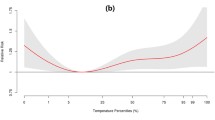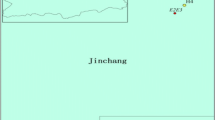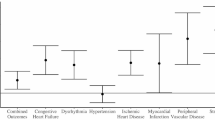Abstract
This study evaluated the effect of extreme temperatures on events requiring emergency room visits (ERVs) for hypertensive disease, ischemic heart disease (IHD), cerebrovascular disease, and chronic kidney disease (CKD) for population stratified by sex and age living in Taiwan’s metropolitan city from 2000 to 2014. The distributed lag non-linear model was adopted to examine the association between ambient temperature and area-age-sex-disease-specific ERVs for a population aged 40 years and above. The reference temperature was defined by a percentile value to describe the temperature in each city. Area-age-sex-disease-specific relative risk (RR) and 95% confidence intervals (CI) were estimated in association with extreme high (99th percentile) and low (5th percentile) temperatures. Temperature-related ERV risks varied by area, age, sex, and disease. Patients with CKD tend to have comorbidities with hypertensive disease. All study populations with hypertensive disease have significant risk associations with extreme low temperatures with the highest RR of 2.64 (95% CI: 2.08, 3.36) appearing in New Taipei City. The risk of IHD was significantly associated with extreme high temperature for male subpopulation aged 40–64 years. A less significant association was observed between the risks of cerebrovascular disease with extreme temperature. The risk of CKD was most significantly associated with extreme high temperature especially for a subpopulation aged 40–64 years. All study subpopulations with hypertensive disease have significant risk associations with extreme low temperature. Male subpopulations were more vulnerable to extreme temperatures, especially for those aged 40–64 years.


Similar content being viewed by others
Availability of data and materials
Data not available due to [ethical/legal/commercial] restrictions.
References
Abrignani MG, Corrao S, Biondo GB, Lombardo RM, Di Girolamo P, Braschi A, Di Girolamo A, Novo S (2012) Effects of ambient temperature, humidity, and other meteorological variables on hospital admissions for angina pectoris. Eur J Prev Cardiol 19(3):342–348. https://doi.org/10.1177/1741826711402741
American Heart Association (2016) How high blood pressure can lead to kidney damage or failure. https://www.heart.org/en/health-topics/high-blood-pressure/health-threats-from-high-blood-pressure/how-high-blood-pressure-can-lead-to-kidney-damage-or-failure. Accessed 11 Apr 2021
Bai L, Cirendunzhu, Woodward A, Dawa, Zhaxisangmu, Chen B, Liu Q (2014) Temperature, hospital admissions and emergency room visits in Lhasa, Tibet: a time-series analysis. Sci Total Environ 490:838–848. https://doi.org/10.1016/j.scitotenv.2014.05.024
Bai L, Li Q, Wang J, Lavigne E, Gasparrini A, Copes R, Yagouti A, Burnett RT, Goldberg MS, Villeneuve PJ, Cakmak S, Chen H (2016) Hospitalizations from hypertensive diseases, diabetes, and arrhythmia in relation to low and high temperatures: population-based study. Sci Rep 6:30283. https://doi.org/10.1038/srep30283
Basu R, Pearson D, Malig B, Broadwin R, Green R (2012) The effect of high ambient temperature on emergency room visits. Epidemiology 23(6):813–820. https://doi.org/10.1097/EDE.0b013e31826b7f97
Bayentin L, El Adlouni S, Ouarda TB, Gosselin P, Doyon B, Chebana F (2010) Spatial variability of climate effects on ischemic heart disease hospitalization rates for the period 1989-2006 in Quebec, Canada. Int J Health Geogr 9:5. https://doi.org/10.1186/1476-072X-9-5
Borg M, Bi P, Nitschke M, Williams S, McDonald S (2017) The impact of daily temperature on renal disease incidence: an ecological study. Environ Health 16(1):114. https://doi.org/10.1186/s12940-017-0331-4
Bots SH, Peters SAE, Woodward M (2017) Sex differences in coronary heart disease and stroke mortality: a global assessment of the effect of ageing between 1980 and 2010. BMJ Glob Health 2(2):e000298. https://doi.org/10.1136/bmjgh-2017-000298
Bunker A, Wildenhain J, Vandenbergh A, Henschke N, Rocklov J, Hajat S, Sauerborn R (2016) Effects of air temperature on climate-sensitive mortality and morbidity outcomes in the elderly; a systematic review and meta-analysis of epidemiological evidence. EBioMedicine 6:258–268. https://doi.org/10.1016/j.ebiom.2016.02.034
Butler-Dawson J, Krisher L, Asensio C, Cruz A, Tenney L, Weitzenkamp D, Dally M, Asturias EJ, Newman LS (2018) Risk factors for declines in kidney function in sugarcane workers in Guatemala. J Occup Environ Med 60(6):548–558. https://doi.org/10.1097/jom.0000000000001284
Centers for Disease Control and Prevention (2011) Principles of epidemiology in public health practice. An introduction to applied epidemiology and biostatistics, Atlanta
Chang LT, Hong GB, Weng SP, Chuang HC, Chang TY, Liu CW, Chuang WY, Chuang KJ (2019) Indoor ozone levels, houseplants and peak expiratory flow rates among healthy adults in Taipei, Taiwan. Environ Int 122:231–236. https://doi.org/10.1016/j.envint.2018.11.010
de Lorenzo A, Liaño F (2017) High temperatures and nephrology: the climate change problem. Nefrología (English Edition) 37(5):492–500. https://doi.org/10.1016/j.nefroe.2016.12.015
Fakheri RJ, Goldfarb DS (2011) Ambient temperature as a contributor to kidney stone formation: implications of global warming. Kidney Int 79(11):1178–1185. https://doi.org/10.1038/ki.2011.76
Fares A (2013) Winter hypertension: potential mechanisms. Int J Health Sci, Qassim University 7(2):10
Fraser SD, Roderick PJ, May CR, McIntyre N, McIntyre C, Fluck RJ, Shardlow A, Taal MW (2015) The burden of comorbidity in people with chronic kidney disease stage 3: a cohort study. BMC Nephrol 16:193. https://doi.org/10.1186/s12882-015-0189-z
Gasparrini A, Armstrong B, Kenward MG (2010) Distributed lag non-linear models. Stat Med 29(21):2224–2234. https://doi.org/10.1002/sim.3940
Goldberg I, Krause I (2016) The role of gender in chronic kidney disease. Eur Med J 1:58–64
Guo Y, Gasparrini A, Armstrong B, Li S, Tawatsupa B, Tobias A, Lavigne E, de Sousa Zanotti Stagliorio Coelho M, Leone M, Pan X, Tong S, Tian L, Kim H, Hashizume M, Honda Y, Guo YL, Wu CF, Punnasiri K, Yi SM, Michelozzi P, Saldiva PH, Williams G (2014) Global variation in the effects of ambient temperature on mortality: a systematic evaluation. Epidemiology 25(6):781–789. https://doi.org/10.1097/EDE.0000000000000165
Hodgson LE, Walter E, Venn RM, Galloway R, Pitsiladis Y, Sardat F, Forni LG (2017) Acute kidney injury associated with endurance events-is it a cause for concern? A systematic review. BMJ Open Sport Exerc Med 3(1):e000093. https://doi.org/10.1136/bmjsem-2015-000093
Hsieh FI, Chiou HY (2014) Stroke: morbidity, risk factors, and care in taiwan. J Stroke 16(2):59–64. https://doi.org/10.5853/jos.2014.16.2.59
Huang C, Barnett AG, Wang X, Tong S (2012) Effects of extreme temperatures on years of life lost for cardiovascular deaths: a time series study in Brisbane, Australia. Circ Cardiovasc Qual Outcomes 5(5):609–614. https://doi.org/10.1161/CIRCOUTCOMES.112.965707
Johnson RJ, Sanchez-Lozada LG, Newman LS, Lanaspa MA, Diaz HF, Lemery J, Rodriguez-Iturbe B, Tolan DR, Butler-Dawson J, Sato Y, Garcia G, Hernando AA, Roncal-Jimenez CA (2019) Climate change and the kidney. Ann Nutr Metab 74(Suppl 3):38–44. https://doi.org/10.1159/000500344
Kim E, Kim H, Kim YC, Lee JP (2018) Association between extreme temperature and kidney disease in South Korea, 2003–2013: stratified by sex and age groups. Sci Total Environ 642:800–808. https://doi.org/10.1016/j.scitotenv.2018.06.055
Lavigne E, Gasparrini A, Wang X, Chen H, Yagouti A, Fleury MD, Cakmak S (2014) Extreme ambient temperatures and cardiorespiratory emergency room visits: assessing risk by comorbid health conditions in a time series study. Environ Health 13(1):5. https://doi.org/10.1186/1476-069x-13-5
Lee WC, Lee YT, Li LC, Ng HY, Kuo WH, Lin PT, Liao YC, Chiou TT, Lee CT (2018) The number of comorbidities predicts renal outcomes in patients with stage 3(-)5 chronic kidney disease. J Clin Med 7(12). https://doi.org/10.3390/jcm7120493
Lin YK, Chang CK, Li MH, Wu YC, Wang YC (2012) High-temperature indices associated with mortality and outpatient visits: characterizing the association with elevated temperature. Sci Total Environ 427-428:41–49. https://doi.org/10.1016/j.scitotenv.2012.04.039
Lin YK, Chang CK, Wang YC, Ho TJ (2013) Acute and prolonged adverse effects of temperature on mortality from cardiovascular diseases. PLoS One 8(12):e82678. https://doi.org/10.1371/journal.pone.0082678
Lin YK, Ho TJ, Wang YC (2011) Mortality risk associated with temperature and prolonged temperature extremes in elderly populations in Taiwan. Environ Res 111(8):1156–1163. https://doi.org/10.1016/j.envres.2011.06.008
Lin YK, Maharani AT, Chang FT, Wang YC (2019) Mortality and morbidity associated with ambient temperatures in Taiwan. Sci Total Environ 651(Pt 1):210–217. https://doi.org/10.1016/j.scitotenv.2018.09.161
Lin YK, Sung FC, Honda Y, Chen YJ, Wang YC (2020) Comparative assessments of mortality from and morbidity of circulatory diseases in association with extreme temperatures. Sci Total Environ 723:138012. https://doi.org/10.1016/j.scitotenv.2020.138012
Malig BJ, Wu XM, Guirguis K, Gershunov A, Basu R (2019) Associations between ambient temperature and hepatobiliary and renal hospitalizations in California, 1999 to 2009. Environ Res 177:108566. https://doi.org/10.1016/j.envres.2019.108566
Martinez-Solanas E, Basagana X (2019) Temporal changes in the effects of ambient temperatures on hospital admissions in Spain. PLoS One 14(6):e0218262. https://doi.org/10.1371/journal.pone.0218262
National Health Research Institute and Taiwan Society of Nephrology (2019) Annual report on kidney disease in Taiwan (in Chinese)
Palhares VC, Corrente JE, Matsubara BB (2014) Association between sleep quality and quality of life in nursing professionals working rotating shifts. Rev Saude Publica 48(4):594–601. https://doi.org/10.1590/s0034-8910.2014048004939
Pillai DP (2016) Clinical trend discovery and analysis of Taiwanese health insurance claims data. S.B., Massachusetts Instit Technol
Robinson JR (2014) Puzzled about end-stage renal disease? Nursing made Incredibly Easy!
Sarnak MJ, Amann K, Bangalore S, Cavalcante JL, Charytan DM, Craig JC, Gill JS, Hlatky MA, Jardine AG, Landmesser U, Newby LK, Herzog CA, Cheung M, Wheeler DC, Winkelmayer WC, Marwick TH, Conference P (2019) Chronic kidney disease and coronary artery disease: JACC state-of-the-art review. J Am Coll Cardiol 74(14):1823–1838. https://doi.org/10.1016/j.jacc.2019.08.1017
Song X, Wang S, Hu Y, Yue M, Zhang T, Liu Y, Tian J, Shang K (2017) Impact of ambient temperature on morbidity and mortality: an overview of reviews. Sci Total Environ 586:241–254. https://doi.org/10.1016/j.scitotenv.2017.01.212
Susskind J, Schmidt GA, Lee JN, Iredell L (2019) Recent global warming as confirmed by AIRS. Environ Res Lett 14(4). https://doi.org/10.1088/1748-9326/aafd4e
Tamosiunas A, Luksiene D, Baceviciene M, Bernotiene G, Radisauskas R, Malinauskiene V, Kranciukaite-Butylkiniene D, Virviciute D, Peasey A, Bobak M (2014) Health factors and risk of all-cause, cardiovascular, and coronary heart disease mortality: findings from the MONICA and HAPIEE studies in Lithuania. PLoS One 9(12):e114283. https://doi.org/10.1371/journal.pone.0114283
Tawatsupa B, LLY L, Kjellstrom T, Seubsman S-A, Sleigh A, Thai Cohort Study T (2012) Association between occupational heat stress and kidney disease among 37,816 workers in the Thai Cohort Study (TCS). J Epidemiol 22(3):251–260. https://doi.org/10.2188/jea.je20110082
Tian Y, Liu H, Si Y, Cao Y, Song J, Li M, Wu Y, Wang X, Xiang X, Juan J, Chen L, Wei C, Gao P, Hu Y (2019) Association between temperature variability and daily hospital admissions for cause-specific cardiovascular disease in urban China: a national time-series study. PLoS Med 16(1):e1002738. https://doi.org/10.1371/journal.pmed.1002738
Tonelli M, Wiebe N, Guthrie B, James MT, Quan H, Fortin M, Klarenbach SW, Sargious P, Straus S, Lewanczuk R, Ronksley PE, Manns BJ, Hemmelgarn BR (2015) Comorbidity as a driver of adverse outcomes in people with chronic kidney disease. Kidney Int 88(4):859–866. https://doi.org/10.1038/ki.2015.228
Turner LR, Barnett AG, Connell D, Tong S (2012) Ambient temperature and cardiorespiratory morbidity: a systematic review and meta-analysis. Epidemiology 23(4):594–606. https://doi.org/10.1097/EDE.0b013e3182572795
Wang LS, Wang S, Guo LJ (2015) Survey and analysis of nurses’ mental stress (in Chinese). China J Pharm Econ 10:082
Wang X, Lavigne E, Ouellette-kuntz H, Chen BE (2014) Acute impacts of extreme temperature exposure on emergency room admissions related to mental and behavior disorders in Toronto, Canada. J Affect Disord 155:154–161. https://doi.org/10.1016/j.jad.2013.10.042
Wang YC, Lin YK, Chuang CY, Li MH, Chou CH, Liao CH, Sung FC (2012) Associating emergency room visits with first and prolonged extreme temperature event in Taiwan: a population-based cohort study. Sci Total Environ 416:97–104. https://doi.org/10.1016/j.scitotenv.2011.11.073
Weidner G (2000) Why do men get more heart disease than women? An international perspective. J Am Coll Heal 48(6):291–294. https://doi.org/10.1080/07448480009596270
Weinstein JR, Anderson S (2010) The aging kidney: physiological changes. Adv Chronic Kidney Dis 17(4):302–307. https://doi.org/10.1053/j.ackd.2010.05.002
Wen CP, Cheng TY, Tsai MK, Chang YC, Chan HT, Tsai SP, Chiang PH, Hsu CC, Sung PK, Hsu YH, Wen SF (2008) All-cause mortality attributable to chronic kidney disease: a prospective cohort study based on 462 293 adults in Taiwan. Lancet 371(9631):2173–2182. https://doi.org/10.1016/s0140-6736(08)60952-6
World Health Organization (2018) Global health estimates 2016: deaths by cause, age, sex, by country and by region, 2000- 2016. https://www.who.int/healthinfo/global_burden_disease/estimates/en/. Accessed 03 July 2020
Xiong J, Lan L, Lian Z, Lin Y (2016) Effect of different temperatures on hospital admissions for cardiovascular and cerebrovascular diseases: a case study. Indoor Built Environ 26(1):69–77. https://doi.org/10.1177/1420326x15604492
Xu D, Zhang Y, Wang B, Yang H, Ban J, Liu F, Li T (2019) Acute effects of temperature exposure on blood pressure: an hourly level panel study. Environ Int 124:493–500. https://doi.org/10.1016/j.envint.2019.01.045
Ye X, Wolff R, Yu W, Vaneckova P, Pan X, Tong S (2012) Ambient temperature and morbidity: a review of epidemiological evidence. Environ Health Perspect 120(1):19–28. https://doi.org/10.1289/ehp.1003198
Youngquist ST, Hood CH, Hales NM, Barton CC, Madsen TE, Arden Pope C (2016) Association between EMS calls and fine particulate air pollution in Utah. Air Qual Atmos Health 9(8):887–897. https://doi.org/10.1007/s11869-016-0392-5
Zhan ZY, Yu YM, Qian J, Song YF, Chen PY, Ou CQ (2018) Effects of ambient temperature on ambulance emergency call-outs in the subtropical city of Shenzhen, China. PLoS One 13(11):e0207187. https://doi.org/10.1371/journal.pone.0207187
Zhang A, Hu W, Li J, Wei R, Lin J, Ma W (2019) Impact of heatwaves on daily outpatient visits of respiratory disease: a time-stratified case-crossover study. Environ Res 169:196–205. https://doi.org/10.1016/j.envres.2018.10.034
Zhang Y, Yan C, Kan H, Cao J, Peng L, Xu J, Wang W (2014) Effect of ambient temperature on emergency department visits in Shanghai, China: a time series study. Environ Health
Acknowledgements
We would like to thank the Ministry of Health and Welfare, Environmental Protection Administration and Central Weather Bureau, Executive Yuan for providing research data. Interpretations and conclusions herein do not necessarily represent the views of these agencies.
Funding
This study was supported by grants from the Taiwan Ministry of Science and Technology (MOST 108-2625-M-033-002- and MOST 106-2221-E-033-006-MY2), National Health Research Institutes (NHRI-107A1-EMCO-3617191, NHRI-106A1-PDCO-3617191, and MOHW105-TDU-M-212-113003), and Taiwan CWB (MP10501-0125), the Ministry of Health and Welfare (MOHW109-TDU-B-212-114004).
Author information
Authors and Affiliations
Contributions
YKL, YCW, and MTK conceptualization; YCW, YKL, and YZ writing - original draft; MTK and YCW formal analysis; and YCW and GA writing - review and editing. All authors read and approved the final version of the manuscript.
Corresponding author
Ethics declarations
Ethics approval and consent to participate
Not applicable.
Consent for publication
Not applicable.
Competing interests
The authors declare no competing interests.
Additional information
Publisher’s note
Springer Nature remains neutral with regard to jurisdictional claims in published maps and institutional affiliations.
Rights and permissions
About this article
Cite this article
Lin, YK., Zafirah, Y., Ke, MT. et al. The effects of extreme temperatures on emergency room visits—a population-based analysis by age, sex, and comorbidity. Int J Biometeorol 65, 2087–2098 (2021). https://doi.org/10.1007/s00484-021-02166-1
Received:
Revised:
Accepted:
Published:
Issue Date:
DOI: https://doi.org/10.1007/s00484-021-02166-1




